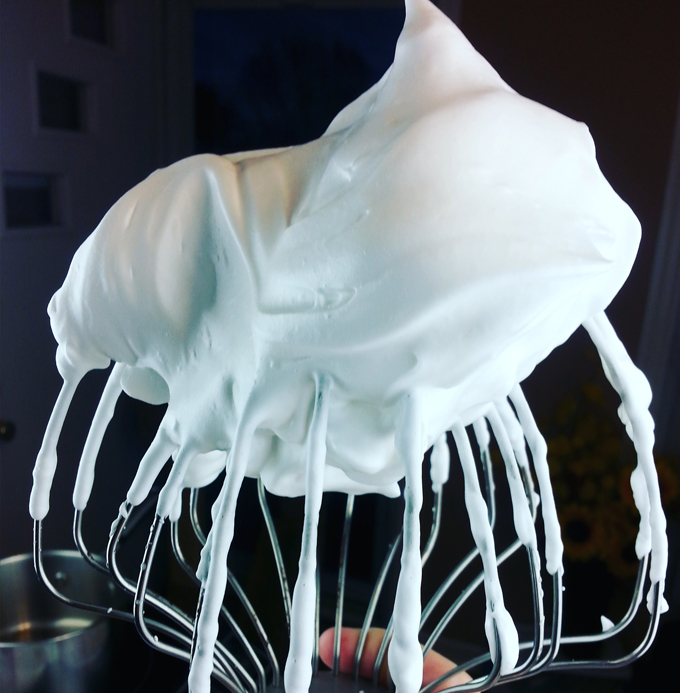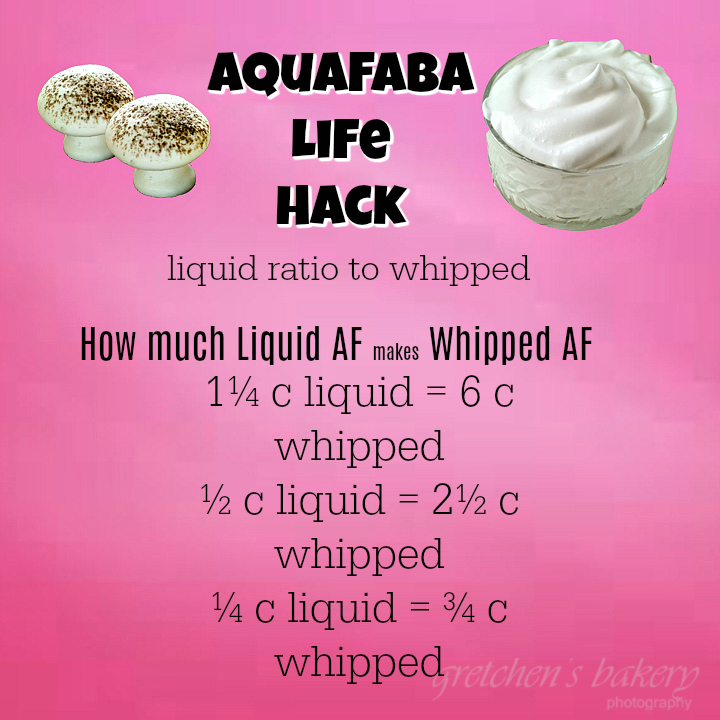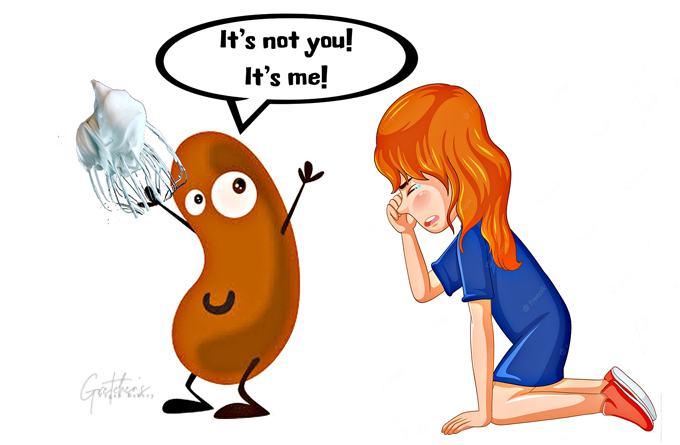Introducing the Aquafaba Meringue Life Hack!
In order to create a stable mousse that will hold up to slicing and not lose it’s integrity before you even get to the event my first trick was to add agar to the reduced bean water

This trick will automatically stabilize and strengthen any meringue for whatever recipe you are making!
The new found stability of the meringue base really proved helpful in the final strength of the cake; but what I found was that to whip such a small amount of aquafaba (with or with out the agar) was always a bit tricky.
Especially for people using hand mixers, I’ve been told it was a bit of a problem.
So in addition to my secret stabilization weapon (agar) I developed what I am calling my Aquafaba Meringue Hack.
By whipping aquafaba in bulk you get a much stronger more stable meringue and then you will only use the amount of whipped that you need to fold into your recipe.
But what to do with all that leftover meringue you might ask?
Refrigerate it! It will deflate over time and go almost back to liquid, but by simply re-whipping it again later (3 and 4 times even!) it will whip back up to perfectly beautiful, stiff, glossy meringue just like it was the first time.
Below is a chart to help you figure out just how much whipped meringue you would use when the recipe calls for it in liquid form first.

WATCH THE YOUTUBE VIDEO TUTORIAL WHERE I SHOW YOU FIRST HAND!

Notes for Success:
Cream of tartar is an acid that helps to strengthen the meringue, if you cannot get it simply wipe the bowl of your mixer with lemon juice or vinegar
I also mentioned that I have been doing this for my Swiss Aquafaba Meringue Buttercream for added stabilization to the recipe, again it works like a charm!
- 1 cup liquid aquafaba
- 1½ teaspoon powdered agar
- Cream of Tartar ¼ teaspoon
- Prepare the stabilized aquafaba by heating it over low heat with the agar powder and bring it to a boil.
- Cool to tepid (not cold or the agar will thicken the liquid before we can whip it)
- Whip with a stand mixer with the balloon whip attachment to frothy and then add the cream of tartar.
- Continue whipping to thick glossy peaks (total time should be about 10 minutes)
- Use the whipped AF as needed in your recipes
**Additional Note:
As usual I have the BEST viewers and visitors here to my blog and I was waiting for someone to ask this question re: My Chart above for the conversion from liquid to whipped AF.
Here is what she wrote and my then response:
Hi, Gretchen. I’m trying to understand the ratio here and if I do the math, I come up with 1 1/4 cup(instead of 3/4 cup) if I start with 1/4 cup liquid. I’m I wrong ?
Hi Diane, yes I was waiting for someone to call me on that. This is a very loose math conversion. Since I started with 1¼ cups liquid and got a very estimated volume of 6 cups. (Since volume measure is never exact really anyway)
so the next breakdown would be Half of 1¼ liquid = ½ cup + 2 Tbs. But since there are rarely any recipes calling for ½ cup + 2Tbs – I rounded down to ½ cup liquid would probably whip up closer to 2 cups volume in meringue.
The next breakdown conversion would be ¼ c + 1 Tbs – again I rounded down to just a ¼ cup which when whipped would yield about 1 cup
I had been doing it that way in my recent Pumpkin Mousse & Raspberry Mousse cakes and those amounts whipped (from my first attempts at whipping the tiny ¼ cup liquid amounts) seems to yield very close amounts to those I listed on the chart.
Hope that makes sense? And i know… it’s NOT EXACT which is strange for me and baking altogether, but it works!
*especially since what I noticed when I whipped just the 1/4 cup called for in the recipe, my volume whipping that small amount was actually slightly LESS (and less strong) than when I whipped in bulk, so I felt better about rounding DOWN since I didn’t want the recipes to be getting MORE whipped AF than any original author would have intended.


Hi, Gretchen. I’m trying to understand the ratio here and if I do the math, I come up with 1 1/4 cup(instead of 3/4 cup) if I start with 1/4 cup liquid. I’m I wrong ?
Hi Diane, yes I was waiting for someone to call me on that. This is a very loose math conversion. Since I started with 1¼ cups liquid and got a very estimated volume of 6 cups. (Since volume measure is never exact really anyway)
so the next breakdown would be Half of 1¼ liquid = ½ cup + 2 Tbs. But since there are rarely any recipes calling for ½ cup + 2Tbs – I rounded down to ½ cup liquid would probably whip up closer to 2 cups volume in meringue.
The next breakdown conversion would be ¼ c + 1 Tbs – again I rounded down to just a ¼ cup which when whipped would yield about 1 cup
I had been doing it that way in my recent Pumpkin Mousse & Raspberry Mousse cakes and those amounts whipped (from my first attempts at whipping the tiny ¼ cup liquid amounts) seems to yield very close amounts to those I listed on the chart.
Hope that makes sense? And i know… it’s NOT EXACT which is strange for me and baking altogether, but it works! 😀
*especially since what I noticed when I whipped just the 1/4 cup called for in the recipe, my volume whipping that small amount was actually slightly LESS (and less strong) than when I whipped in bulk, so I felt better about rounding DOWN since I didn’t want the recipes to be getting MORE whipped AF than any original author would have intended.
Hi 🙂 I was wondering when do I add the cream of tartar? I found this video when looking at your Chocolate mousse cake recipe. I just don’t see when to add the cream of tartar.
Thank you 🙂
Hey thanks! Sorry about that, I’ll update the post ~ the cream of tartar gets added to the liquid aquafaba before whipping
Gretchen, I was excited to find this hack. Made your Coconut Cream Pie and was making the Aquafaba Meringue but am missing when you sweeten it. I will wing it for now but let us know at what point to add some sugar.
I will research your blog more but just found myself in a crunch time wise today.
Thanks, you are truly amazing.
Would using agar in the meringue for an italian buttercream not work because of the hot sugar addition? How this plus xanthum gum?
That would still work. As the meringue cools down the agar will start to strengthen it. I prefer to use cream of tartar but you can use xanthan if you prefer
Have you tried seeing if the agar possibly adds enough stability to the meringue to make an angel cake with?
I have not yet, but will plan to work on that
Cream of Tarter & hydrocolloids like agar or xanthan gum are not substitutes for each other, even though they can sometime have the same effect, but that happens through 2 entirely different chemical/physical mechanisms: Cream of Tarter is an acid & can be replaced for citric acid, lemon juice or vinegar. Agar forms a gel & will work with plain water, whereas CoT would do nothing to help whip plain water.
Note that agar & xanthan or guar gums are also not always good substitutes for each other. They are all hydrocolloid “gums” but agar (like starches) only requires a hot liquid to dissolve, but create a gel when cooled (a “brittle” gel like Jello) whereas the other two gums are thickeners when used individually, but they do dissolve in cold liquids, That’s why people get disappointed when trying to make solid “vegan cheese” with xanthan gum instead of tapioca starch.
However, a combination of both xanthan & guar gums does synergize to form a gel and, in fact, it is more of a stretchy gel than from agar…but, like agar, it will still melt to a liquid when heated. In addition, using such a combination requires less total gum. (And, BTW, combining either with agar does not create that stretchy gel…whereas combining agar & pectin DOES! Plus, this combo works with very acid liquids like fruit juices.) It’s all quite fascinating!
Great! Thank you!!
Have you tried agar with the IMBC?
I have not, but it works in swiss, so I suspect it will work in italian as well
Hi Gretchen,
So if i was trying to incorporate agar into your swiss meringue buttercream, would i follow the recipe you have that says to reduce the aquafaba then let it cool completely before whipping? Or would i reduce it, add the agar and boil for a few secs as per this video, and then whip it while its still warm? Would that not mess up the swiss meringue recipe since its not cold when whopping? Thanks 🙂
Yes you can do as you stated in the 2nd scenario, whip it when it is cooled but not too cool or you will see the agar will start to set. Its fine to whip the AF when it’s not cold, it just takes longer, so try to cool it as much as possible – just before it gets cool so much that is starts to set the agar, you would visibly see that happen if you monitor it as it cools
Hi, I didn’t use agar but after adding sugar, my aquafaba deflated and it’s now soupy. Did I add the (coconut) sugar and almond extract too soon? Anything I can make with a soupier mix? 🙂 Thanks!
AF can be a tricky bugger! You can try to reboil it, reduce it a bit (with the sugar in there, it’s Ok) and then rewhip. It is forgiving thankfully, so you can always rewhip after it has deflated- like deflated back to liquid.. which can take a little hile (I leave it in the fridge overnight) and by morning it is usually almost liquid again, a bit foamy but thats ok too
If one adds agar to the aquafaba when heating, should that come before or after the sugar to the aquafaba? I’m making the Swiss Buttercream from your book and found your hack.
I have tried making regular meringue ie. egg whites and coconut sugar and italian meringue with coconut sugar syrup. On both occasions it didn’t work. Meringue went soupy and syrup didn’t reach the required temp temperature. I think there is more moisture/water in coconut sugar and that’s the reason for those reactions and probably the deflation of your meringue Renu.
Hi Gretchen, if I use say canellini bean af will I be able to follow the recipe and quantities as above, also will I be able to re-whip it if deflates overnight? Very interested in this thank you for tips.
HI there, while I have not tried any other bean for AF besides chickpea, I have heard that many others will work exactly same
Hi Gretchen,
I would like to use a plain sweetened AF meringue to decorate culcakes, ie AF, sugar, agar, cream of tartar.
Will it stay stable over time? Will it dry or change color?
Also, could I add matcha powder to flavor it?
Thank you
Hi Gretchen,
Thank you for this wonderful trick and explanation, I’ve made it today with chickpeas’ water from a jar and worked well, I’m making a mousse later.
Does this method work with aquaflaxa as well?
Great! I have not tried it with the flax whites
Hii would agar work with making meringue for macarons?
I am not an avid macaron maker, so it is hard for me to say yes or no. While the concept seems to lend itself well to that application, I would have to say it is worth a try!
hy gretchen
thanks for you page amazing recipts, its like a vegan heaven. 😍
unfortunately i dont manage to wihip the aqua faba. maybe beacuse i use a hand mixer ??
Are you putting agar agat in every meriunge cream you do ? I haven’t noticed it in other of your recipts.
i know you are saying and from bakery generell dont change the ingridiens, but i am alergic to agar agar 😩
it there any vegan sotutie for that ??
thank you many greetings
Hi there, unfortunately AF is very hard to whip without the balloon whip & power of an electric stand mixer, not to say that it can’t be done, but those who have done it with a hand beater say it is not very strong & it almost burns out their machine
You can leave out the agar it is no problem